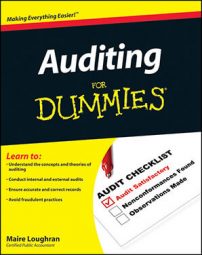After completing your risk assessment procedures and deciding if any misstatements are material, you need to evaluate your findings. You must decide if you can use normal audit procedures (for a low-risk assessment) or if you have to use extended procedures (for a high-risk assessment).
After looking at major financial statement accounts or classes of transactions, if you decide the risk of material misstatement is relatively low, you design your audit procedures accordingly. Here are three characteristics of company transactions indicating low risk:
Like transactions are handled in the same way: For example, all customers who purchase on account are set up in the accounts receivable subsidiary ledger, and the invoice amount due is immediately booked. The accounts receivable subsidiary ledger is a listing of all customers and is usually ordered alphabetically by customer name or by customer account numbers. The ledger also reports the current amount each customer owes.
You encounter many recurring transactions: These types of transactions take place every month. For example, each month the company makes an accrual for payroll earned but not paid.
The transactions are easy to measure: Straight-out revenue and expense transactions the company records when they happen are easy to measure. In contrast is revenue recorded under percentage of completion. This is a method of recognizing construction revenue and expenses in stages that can be very subjective and open to error.
Many audit firms assign less experienced auditors to work low-risk engagements and save the big guns for the tough cases. That means that as a staff associate, you’ll more than likely have the pleasure of working these easier engagements early in your career.
Also, in low-risk situations, sample sizes (the number of records you look at) will be set at normal levels. Normal levels of any audit criteria are usually set as firm policy, meaning that your senior associate will tell you what size samples to use.
Professional skepticism is also set at normal levels, which simply means you’ll be more apt to take transactions at face value. In other words, you assume the transactions are correct unless you discover otherwise.

